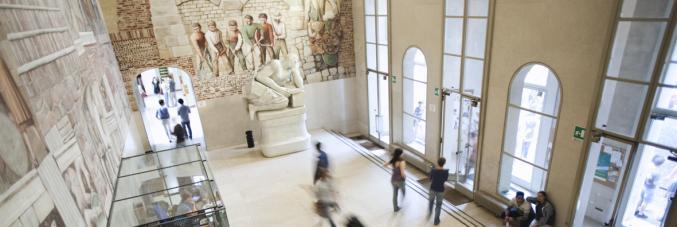
Palazzo Liviano in the palm of your hand, with an app
22.03.2022
Under the supervision of Prof Chiara Ponchia and Prof Nicola Orio, the Portuguese Erasmus student Raquel Pedro developed the app as part of the Erasmus + Traineeship in collaboration with the Department of Cultural Heritage of the University of Padua and the Departamento de Estudos Comparatistas - Arte e Literatura Comparadas of the Universidade de Lisboa.
Palazzo Liviano was part of the main building development projects initiated by the University of Padua Rector Carlo Anti (1932-1943), which brought some of the greatest Italian artists to Padua to design, expand and enrich university buildings. In 1934, the Milanese architect and designer Gio Ponti won a competition to construct the Liviano dedicated as the new arts faculty. In addition to the design of the building, Ponti personally selected the furnishing elements: benches, desks, chairs, even the clothes hangers. The entire decor bears his mark, giving the interiors the same recognizable and coherent style found in some rooms of Palazzo Bo, also furnished by Ponti
As Gio Ponti notes on the project drawings, the monumental entrance "from the outside" unveils the large fresco of Campigli measuring 260 square meters on the south and east walls, then leads to the atrium that functions in connecting with the Sala dei Giganti is a restored conference room. The fresco, painted by Massimo Campigli, was inspired by the work of Tito Livio, hence named "Palazzo del Liviano". The north wall houses the staircase leading to the Sala dei Giganti and the spiral staircase to the museum on the third floor. Among other works of art preserved in the building is the statue of Tito Livio by the sculptor Arturo Martini (1942) placed in the atrium with the Latin historian bent over in reflection like "a child who kneels and writes all his life", according to the artist's definition.
The app offers a short tour of the atrium of Palazzo Liviano via smartphone: visitors begin by scanning a QR code placed on a pedestal at the entrance giving access to web pages. Visitors are taken on a journey in stages, guided by the discovery of the history of the building, the frescoes by Massimo Campigli and the statue of Tito Livio by Arturo Martini. The texts are available in four languages(Italian, English, Spanish, and Portuguese), and videos in LIS (Italian Sign Language). Texts and images correspond to a responsive site ar accessible from various mobile devices (both Android and iOS). Raquel Matias Hilário Pedro wrote the texts based on the bibliographic research carried out during the internship at the Department of Cultural Heritage and took care of the translations and organized each stage of its application, while Daniel Zilio developed the web pages and Martina Penzo took care of the translation of the texts into LIS.
Raquel Pedro remarks, “The Erasmus Traineeship was a very interesting experience, both in terms of culture and study, especially since I had access to a large art library and got to know some Italian cities.”
Raquel - says Professor Chiara Ponchia – faced many obstacles on her move to Padua last September due to the resurgence of the pandemic. I appreciated her tenacity in solving all the practical problems, her experience shows that, even in such times, we have to roll up our sleeves and try to carry out our projects.



